Plugin User Guides
JHS Loud Is More Good Collection User Guide
Last updated on 21 Oct, 2025
The following article is a condensed version of the user guide. You can learn about more features under the Plugin Interface Overview .
Overview
Known for innovative sound, quality craftsmanship and user-friendly features, JHS pedals have become immensely popular for their blend of vintage character and modern versatility. This collection captures the essence of their pedal-friendly amplifier and its seamless synergy with a curated selection of JHS’s most celebrated pedals, offering everything from transparent overdrive to immersive ambience.
Utilizing our proprietary component-level modeling, we’ve meticulously recreated the amp’s clean, articulate response, tube-like compression, and natural interaction with effects. Every nuance, from its harmonic richness to the way it shapes and enhances pedals, has been faithfully recreated.
Global Plugin Features
The top section of every MixWave plugin interface includes a range of global plugin features, detailed in the Amp Plugin Global Features article . Additionally, it features a preset browser, which is explained in the Plugin Presets and Locations article .
Artists Presets
The plugin includes artist presets from Josh Scott, Adam Dodson, Bearamic, Charlie Robbins, Jake Bynes, Mark Abrams, Nicol Wheeler, Sarah Longfield, Taylor Larson, The Donut Doctor, Walter Druce and more. The presets can be accessed through the plugin preset menu.
Pedals & Effects
The following pedals and effects are also available as separate plugins, that includes a slightly different global interface. To learn more about their shared global controls, see the Pedal Plugin Global Features article.
Pulp N Peel
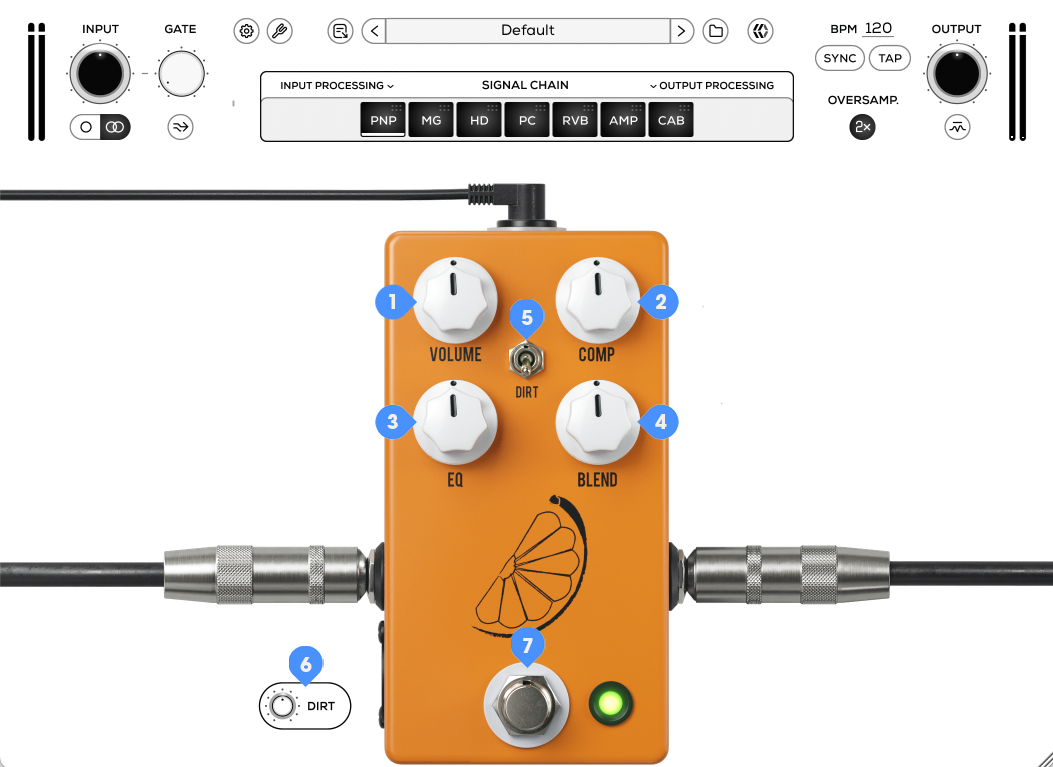
Volume Knob - Controls the overall output volume of the pedal.
Comp Knob - Sets the amount of compression applied to the signal.
EQ Knob - Darkens or brightens the tone. Turning right makes the tone brighter; turning left makes it darker.
Blend Knob - Mixes the compressed signal with the dry (uncompressed) signal. Turning fully right results in full compression/preamp tone, while turning left blends in the original uncompressed tone.
Dirt Toggle - Activates an overdrive circuit.
Dirt Knob - Controls the amount of overdrive and works in conjunction with the Blend control.
Bypass Switch - Engages or disengages the Pulp N Peel pedal.
Morning Glory
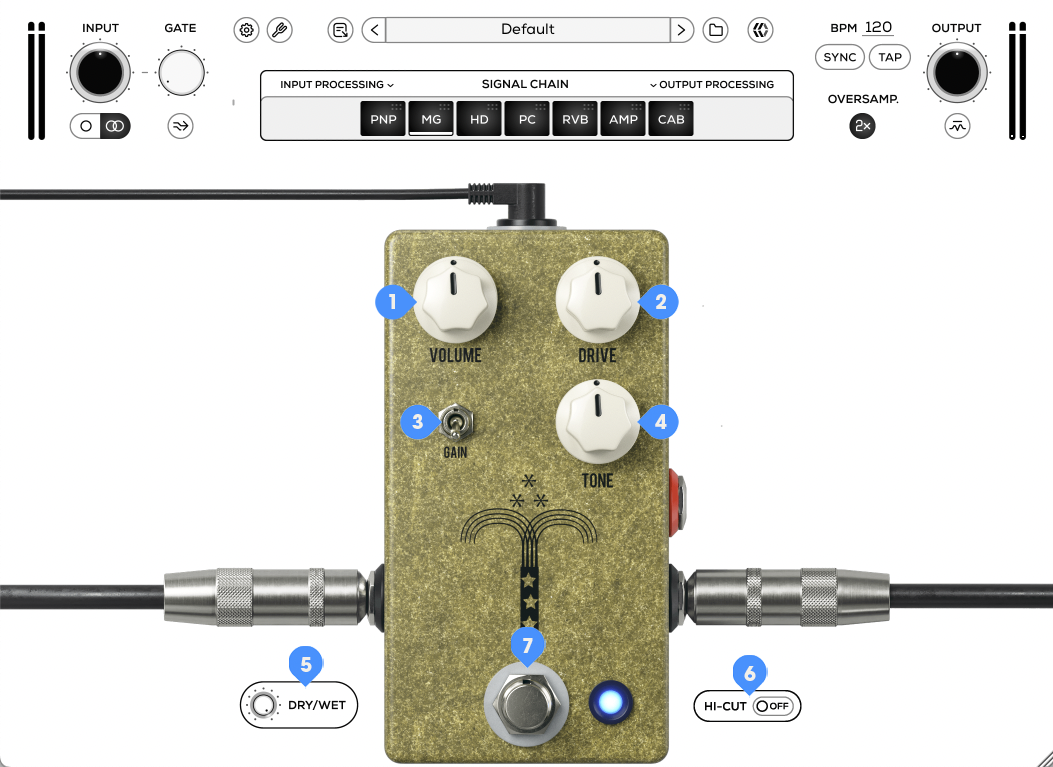
Volume Knob - Controls the overall output volume of the pedal.
Drive Knob - Adjusts the amount of overdrive or gain, similar to cranking a tube amp. Increasing the drive also adds brightness.
Gain Toggle - Engages a higher gain mode when flipped up. The LED changes to red to indicate activation of this mode.
Tone Knob - Modifies the brightness of the overdrive. Turning right results in a brighter tone; turning left yields a darker tone.
Dry/Wet Knob - Controls the level of blend between the “dry” (clean) input signal and the “wet” (processed) signal.
Hi-Cut Switch - Located on the right side of the pedal, this switch cuts the highest frequencies if the overall tone is too bright.
Bypass Switch - Engages or disengages the Morning Glory pedal.
Hard Drive
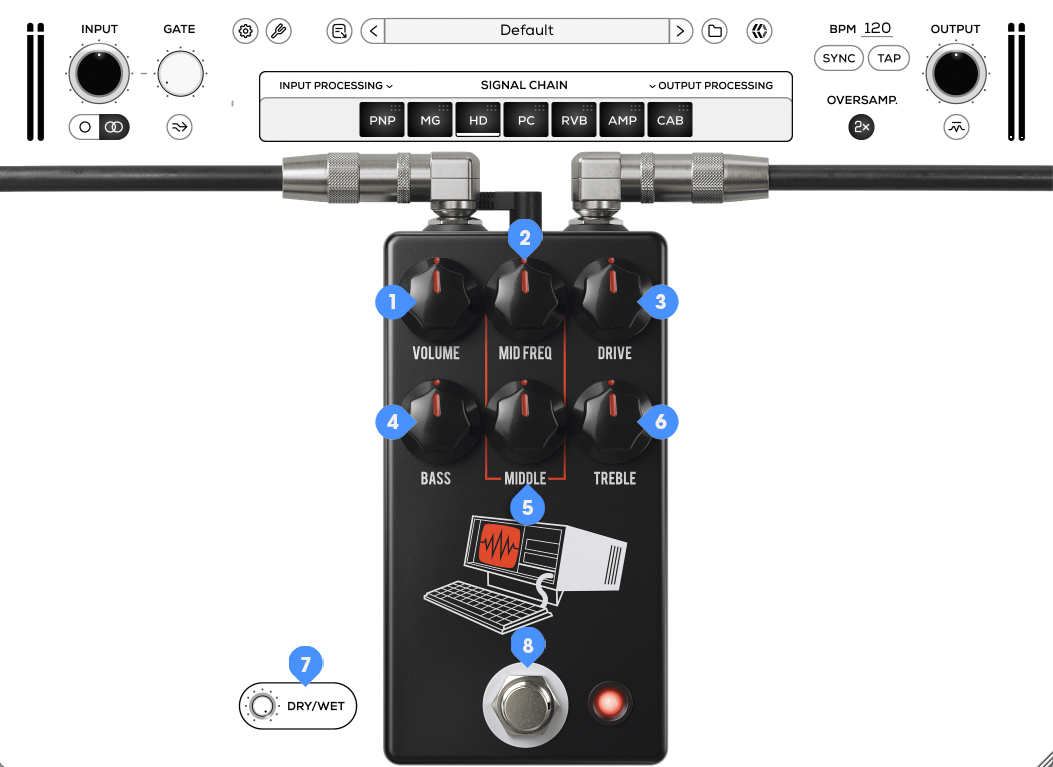
Volume Knob - Controls the overall volume of the pedal.
Mid Freq Knob - Controls which middle frequencies are scooped or boosted by the Middle knob.
Drive Knob - Controls the amount of distortion.
Bass Knob - Controls the bass frequencies level. Noon is flat, left is cut, right is boosted.
Middle Knob - Controls the mid frequencies level. Noon is flat, left is scooped, right is boosted. The frequency range is set by the Mid Freq control.
Treble Knob - Controls the treble frequencies level. Noon is flat, left is cut, right is boosted.
Dry/Wet Knob - Controls the level of blend between the “dry” (clean) input signal and the “wet” (processed) signal.
Bypass Switch - Engages or disengages the Hard Drive pedal.
TIP: To switch the Hard Drive pedal's UI to the tan-colored version, go to Settings > GUI Options > Hard Drive.
Panther Cub
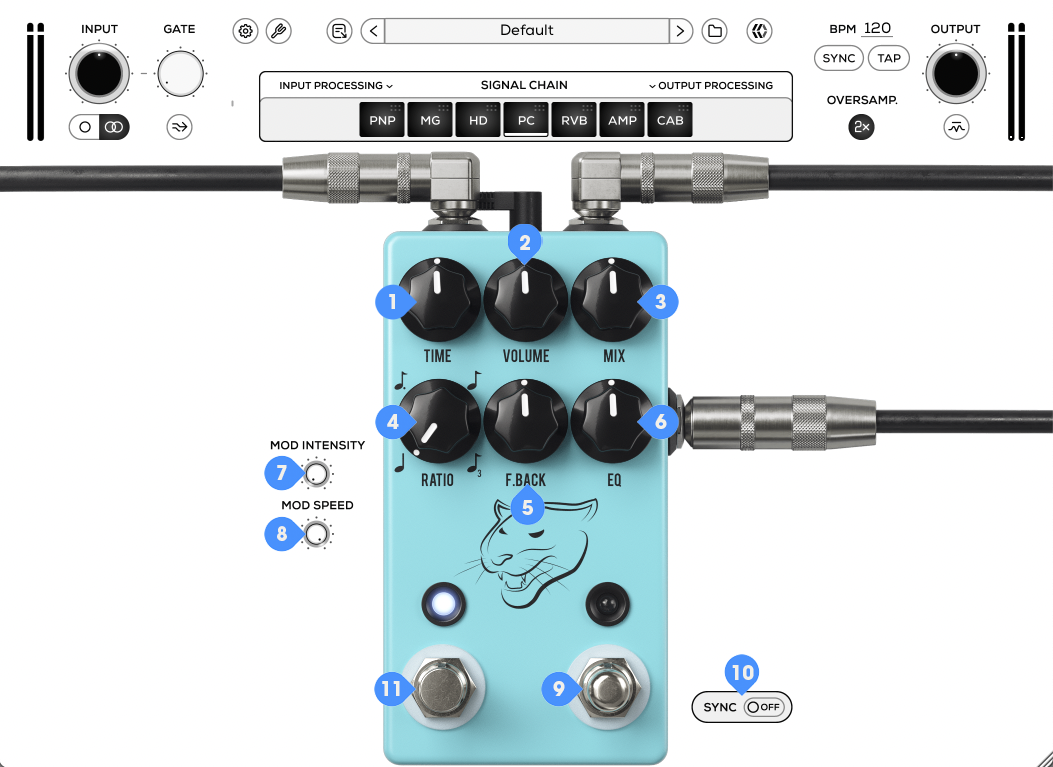
Time Knob - Controls the delay time from 1000ms (left) to 100ms (right).
Volume Knob - Adjusts the overall gain of both dry and wet signals. As you increase the mix, the dry signal decreases; the volume control can compensate or boost the overall signal.
Mix Knob - Controls the volume of the delay repeats only.
Ratio Knob - Determines the tap subdivision, allowing selection between quarter, dotted-eighth, eighth, and triplet note divisions. This setting applies whether using tap tempo or manually adjusting the time knob.
F. Back (Feedback) Knob - Controls the number of delay repeats varying from smooth, infinite repeats or wild oscillation noises.
EQ Knob - An active EQ tilt control. The center position is flat; turning the knob above center boosts highs and cuts lows, while turning it below center boosts lows and cuts highs.
Mod Intensity Knob - Adjusts the depth of the modulation effect.
Mod Speed Knob - Controls the speed of the modulation effect.
Tap Tempo Button - Manually set the speed of the delay by clicking the Tap tempo button.
Sync Switch - Enables synchronization of the delay effect Time control to the host’s tempo in BPM.
Bypass Switch - Engages or disengages the Panther Cub pedal.
TIP: To use the JHS Panther Cub in stereo, select the Stereo Input button with a stereo signal, or use a Mono to Stereo instance of the plugin, and drag and drop the PC module to the last position in the Signal Chain.
NÖTASPRING
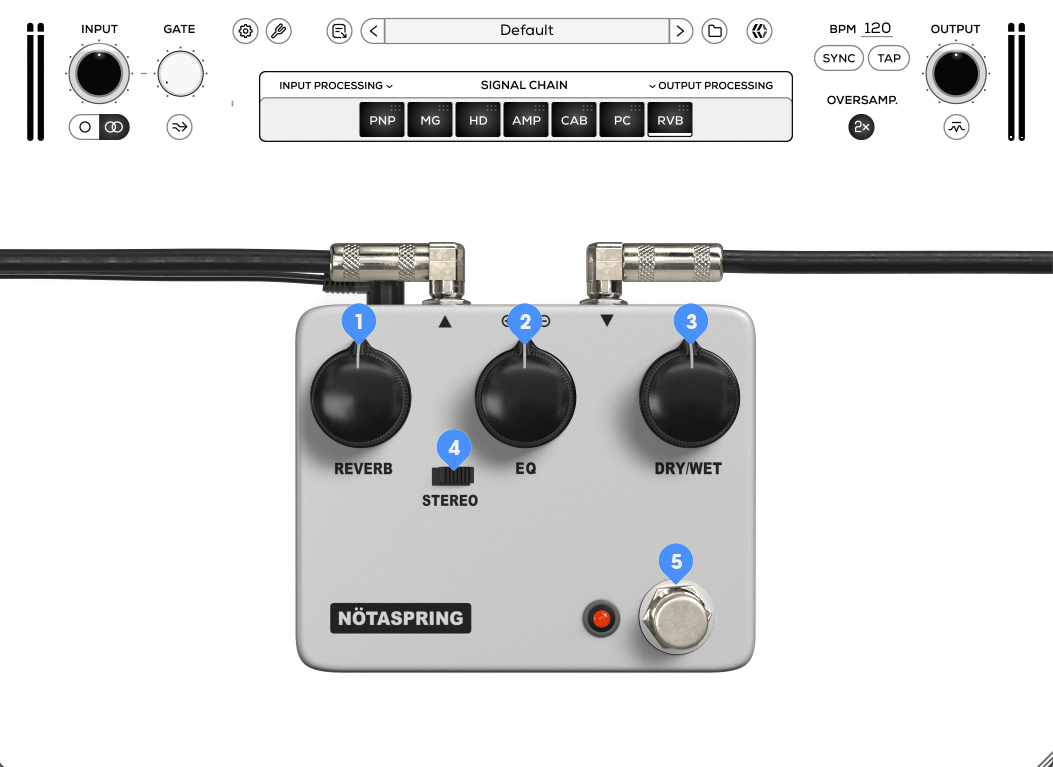
Reverb Knob - Adjusts the amount of the reverb effect.
EQ Knob - Adjusts the brightness of the reverb effect. Turning right results in a brighter tone; turning left yields a darker tone.
Dry/Wet Knob - Controls the level of blend between the “dry” (clean) input signal and the “wet” (processed) signal.
Mono/Stereo Switch - Toggles between a Mono or Stereo reverb.
TIP: Additionally, select the Stereo Input button with a stereo signal, or use a Mono to Stereo instance of the plugin, and drag and drop the RVB module to the last position in the Signal Chain.
Bypass Switch - Engages or disengages the Nötaspring pedal.
Amplifier
Loud Is More Good
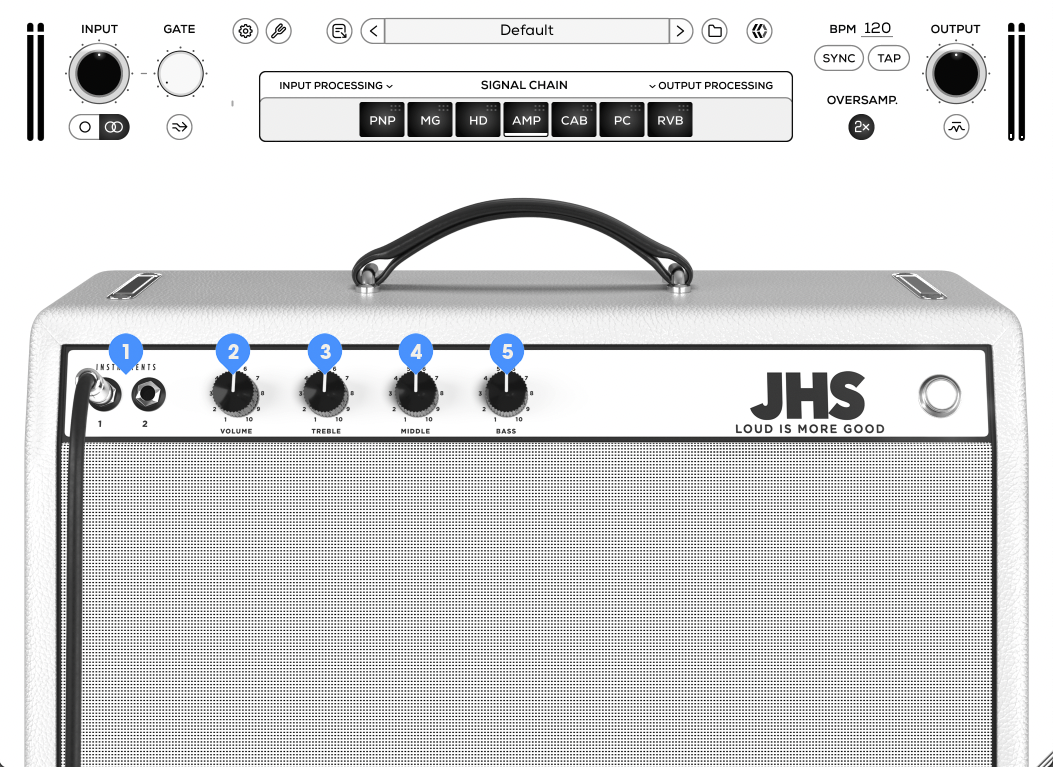
Instrument Inputs - Toggle between the two available inputs allowing to match the amplifier's response to different instruments and playing styles.
Input 1 - The standard input, providing the full, unaltered signal strength of your instrument.
Input 2 - This input is padded, reducing the signal level compared to Input 1. This attenuation is beneficial for instruments with high-output pickups or active electronics, as it helps prevent overdriving of the amplifier's preamp section, ensuring a cleaner tone.
Volume - Adjusts the overall output level of the amplifier. Turning the knob clockwise increases the loudness, while turning it counterclockwise decreases it. This control allows you to set the desired volume for your performance or practice environment.
Treble - Modifies the high-frequency content of your sound. Rotating the knob clockwise enhances the brightness and clarity, adding sparkle to your tone. Conversely, turning it counterclockwise reduces the treble response, resulting in a warmer, mellower sound.
Middle - Controls the midrange frequencies, which are crucial for the body and presence of your guitar tone. Increasing the mids by turning the knob clockwise can make your guitar sound more prominent in a mix, while decreasing them by turning it counterclockwise can produce a scooped, more subdued midrange character.
Bass - Adjusts the low-frequency content. Turning the knob clockwise boosts the bass frequencies, adding depth and fullness to your tone. Turning it counterclockwise reduces the bass response, which can be useful for achieving a tighter, more focused sound, especially in complex mixes or live settings.
Speakers & Cabinets
The cab module features a 1x12 speaker cabinet, accompanied by four speaker options and 21 virtual microphones.
The speaker and cabinet section of every MixWave amp plugin interface includes a range of features, outlined in the Amp Plugin Speakers & Cabinets article .
Microphones
Dynamic 57 – Punchy mids with a tight low end, a classic choice for aggressive guitar tones.
Dynamic 7B – Smooth and warm with a natural midrange, great for taming harshness.
Dynamic 409 – Fat and forward with a bit of bite, excels on crunchy and high-gain tones.
Dynamic 421 – Thick low-mids with a smooth top end, great for adding weight to your tone.
Dynamic 441 – Tight and articulate with a balanced frequency response, detailed without being harsh.
Dynamic R20 – Deep and warm with a tight low-end and reduced proximity effect, great for fuller tones.
Tube 67 – Warm and smooth with a slightly rolled-off top end, perfect for a vintage, rounded sound.
Tube 47 – Rich and full-bodied with a slight vintage warmth, great for adding depth.
Tube 251 – Open and airy with a polished high end, adds clarity to darker tones.
Tube C12 – Bright and silky with a smooth top end, ideal for modern high-fidelity guitar tones.
Tube 800g – Crisp and present with an ultra-detailed high end, great for polished, articulate tones.
Condenser Fet 47 – Solid low-end punch with a clear top-end bite, great for aggressive tones.
Condenser 32 – Bright and detailed with a fast transient response, captures every nuance.
Condenser 4011 – Neutral and natural with extended highs, perfect for a true-to-life cab sound.
Condenser 2011 – Slightly forward mids with a clear and controlled top end.
Condenser 4099 – Detailed and focused, ideal for capturing articulation and harmonics.
Condenser 450 – Side-address condenser with a tight, present midrange, great for edge-of-cone positioning.
Ribbon 122 – Warm and smooth with extended highs, retains the natural body of the cab.
Ribbon 42Bn – Dark and vintage, smooths out high-end fizz while keeping a natural presence.
Ribbon 84 – Classic ribbon warmth with a rich low-mid response and silky highs.
Copper – Lo-fi, midrange-focused with a unique honky character, great for creative textures.
Speakers
Jupiter 12 Ceramic
Jupiter 12 Alnico
Cream 12 Alnico
Jupiter 10 Ceramic
